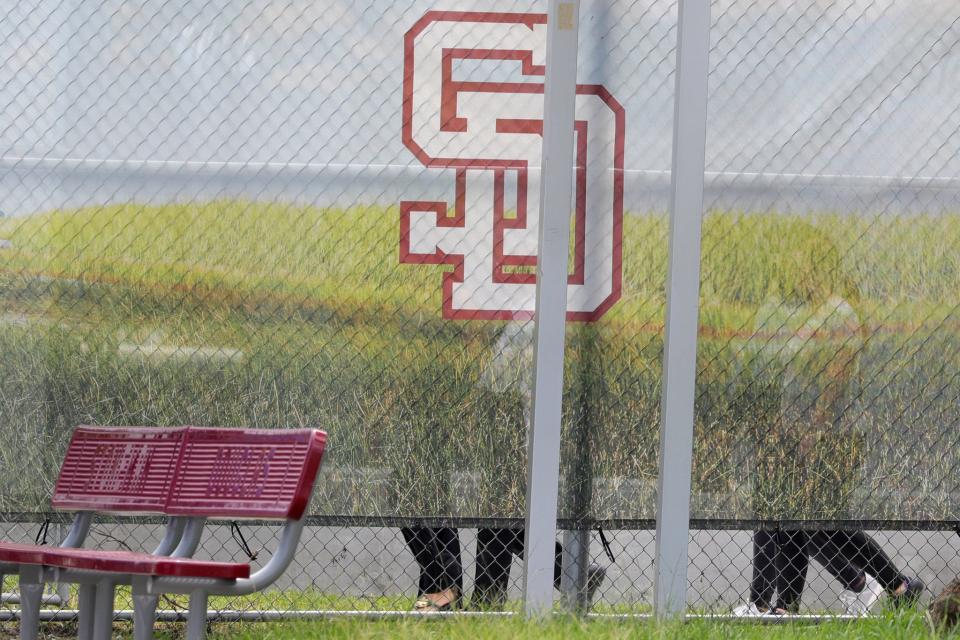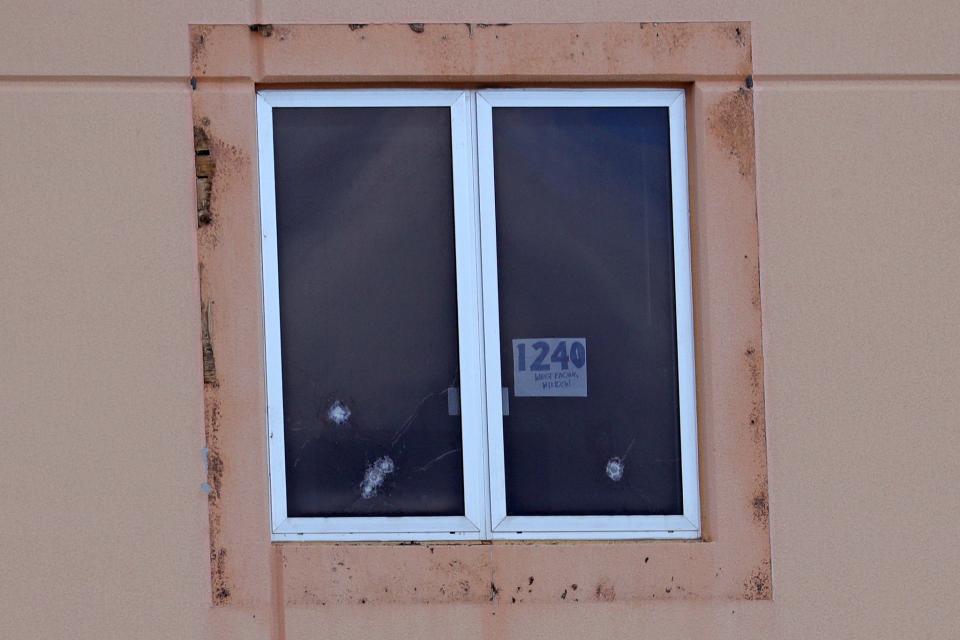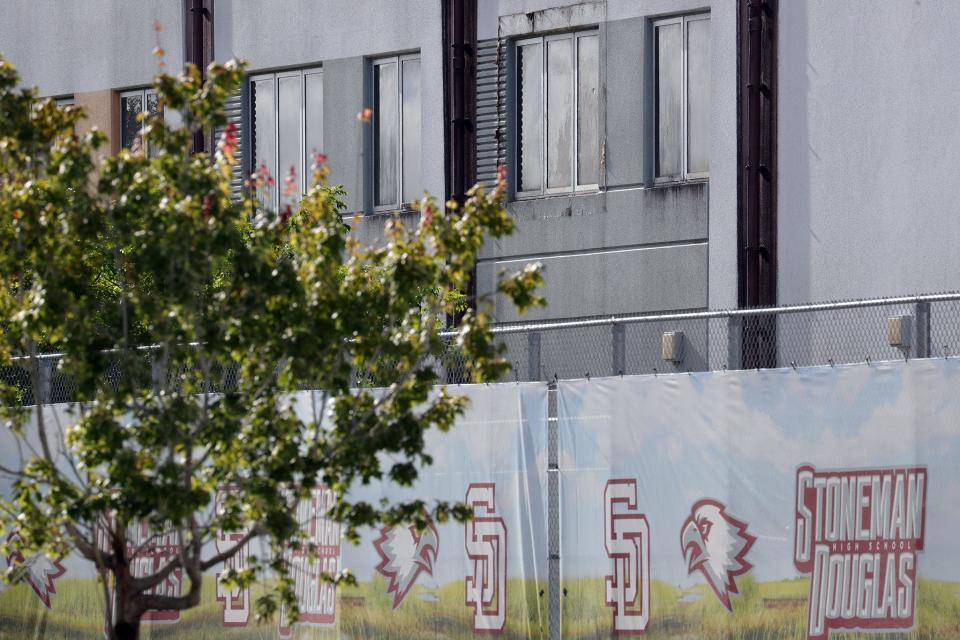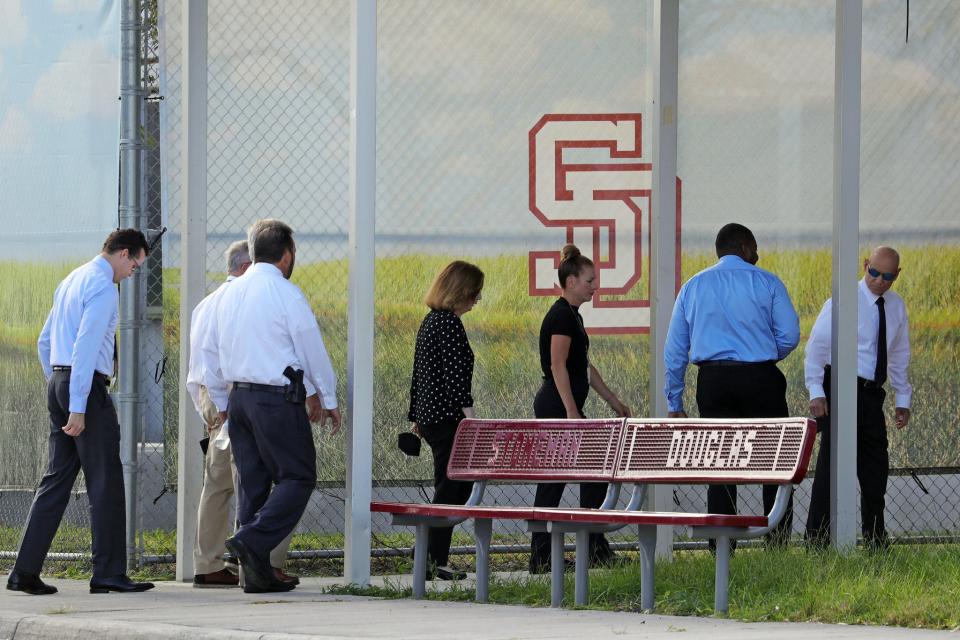'Disturbing on a number of levels': Jurors tour preserved crime scene at Stoneman Douglas High
FORT LAUDERDALE — It's like walking into a graveyard, said the reporters who toured the Marjory Stoneman Douglas High School freshman building on Thursday. The blood on the floor is a flaking, faded brown. The contents of a half-drunk plastic cup on one student's desk are dark and sludgy.
The bodies of Nikolas Cruz's 17 victims are no longer there, but most everything else remains unchanged in the hallways and classrooms, which have been preserved as active crime scenes in Parkland for more than four years.
"This was a very difficult scene to walk through," said Rafael Olmeda, a reporter for the South Florida Sun-Sentinel who was among the five reporters that visited the school as part of the penalty phase of Cruz's sentencing trial. "It was disturbing on a number of levels."
'Life is a Roller Coaster': Victim's poem read to jurors
The prosecutor: Meet the 80-year-old prosecutor making the case for Nikolas Cruz receiving the death penalty
6 minutes of terror: New revelations rise as Parkland survivors recount Nikolas Cruz attack

Their tour through the building follows weeks of testimony against Cruz, who has pleaded guilty to killing 17 people and wounding 17 others on Feb. 14, 2018. A 12-person jury must decide now whether to recommend that he be executed or a sentenced to life in prison without parole. If they choose death, Circuit Judge Elizabeth Scherer will make the final call.
To aid the jury's decision, and against the wishes of Cruz's defense team, prosecutors arranged for a visit Thursday to the 1200 building of Stoneman Douglas, where the attack occurred. Jurors traded their electronics for optional face masks, gloves and shoe coverings before walking inside.
As with all graphic evidence presented over the course of the trial, the judge allowed only five journalists access to it. They toured the school after the jurors left on the condition that they, too, take no photos or videos. Thursday's walkthrough coincided with what would have been the 22nd birthday of Joaquin Oliver, who Cruz shot in the head as he lay wounded in an alcove on the third floor.
"What we saw was the end result of children who were in the middle of an average day, having a really wonderful time," Olmeda said. "And all of a sudden, a nightmare erupts right in front of them."

'It's a sickening feeling': Parkland survivors mourn after school shooting in Uvalde
'Our lives are on the ballot': March for Our Lives Parkland rally calls for gun law reform
Florida talks after Uvalde shooting: Palm Beach County School Board talks security after shooting at a Texas elementary school
Tour of building yields scenes of a Valentine's Day interrupted
The inside of the 1200 building is like a moment frozen in time, Olmeda said: laptops left open and assignments strewn about; an essay, unfinished, about how lucky its writer was to receive an education.
A once-white teddy bear lay discarded on the floor of the stairwell where students fled, added Terry Spencer of The Associated Press and broken glass, wilted rose petals and deflated balloons littered classroom floors.
They saw inexplicable things, too, Spencer said, such as three wall clocks lying face down in a row on the ground, perfectly spaced apart. And terrible things, such as splotches of blood and yellow-greenish "brain matter" on the wall.

Among the most disturbing sights was the alcove where Joaquin died, the reporters said. He was shot first in the leg, and he took cover in an alcove with other injured students. When the others fled, he remained behind, unable to move.
"We don't just see a large pool of blood where Joaquin Oliver died," Olmeda said. "We see a large pool of blood where, we know from testimony, Joaquin Oliver sat and waited, knowing he was next to be shot."
Joaquin raised his hand above his face to protect himself when Cruz stood over him and lifted his rifle. Two bullet holes in the wall "show how vain that attempt was," the reporters wrote.
"When you hear that, and then you see the blood that's left behind, it really strikes you just as a human being," Olmeda said. "How do you contemplate what happened in the last moments of this child's life? This was a child."
They saw a lock of dark hair on the floor near where Joaquin's body would have been, and a blood-soaked Valentine's Day decoration near it.
Olmeda's voice shook as he recounted what he saw. Disturbing as they are, the details he shared are sanitized, he said, scribbled hastily on notepads as he and four others walked through the building.
He watched the jurors, who entered and exited the building before him. They were stone-faced, he said.
Nikolas Cruz's defense team warned tour would 'inflame the jury'
Cruz's defense team contested jurors' access to the school out of concern that it would traumatize them and unduly influence their decision about Cruz's fate. The 12-person jury might be inclined to recommend the death penalty "based on emotion instead of reason," they warned.
They argued that the evidence shown in court was more than enough to familiarize jurors with the case. They've seen footage of the shooting, and photos of its aftermath – most too graphic to be shown to the rest of the courtroom.
Cruz's defense team also took issue with the fact that memorials and photos of the victims decorate the campus and surrounding areas. To expose jurors to these was an attempt by prosecutors to "inflame the jury" and create undue prejudice, they argued.

The "symbolic, personal items" that littered the classrooms and hallways might cause jurors to be "so overcome with sympathy for the victims" that they can't remain impartial, the defense team warned in a motion to the judge, which she ultimately overruled.
Upon returning to the Broward County courthouse, prosecutors called their final witnesses to the stand: the remaining family members of victims who had yet to address jurors.
The special-needs son of Chris Hixon, the Stoneman Douglas athletic director who, at the sound of gunfire, ran into the freshman building to confront Cruz, was among them. Corey Hixon joined his mother at the stand and wrapped his arms around her.
"I miss him!" he shouted.
He started to cry. And for a rare moment, some jurors did, too.
The Associated Press' Terry Spencer, Court TV's Emanuella Grinberg, The Sun-Sentinel's Rafael Olmeda, Local 10's Christina Vasquez and CBS 4's Joan Murray contributed to this report.
Hannah Phillips is a journalist covering public safety and criminal justice at The Palm Beach Post. You can reach her at hphillips@pbpost.com.
This article originally appeared on Palm Beach Post: Marjory Stoneman Douglas crime scene, where Nikolas Cruz killed 17

